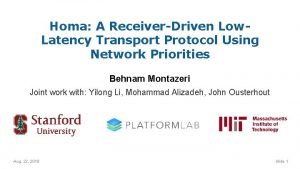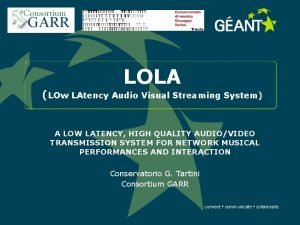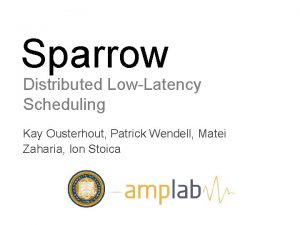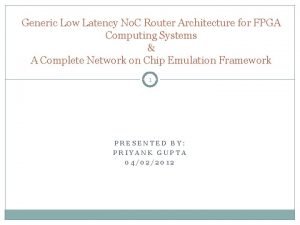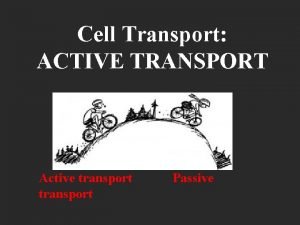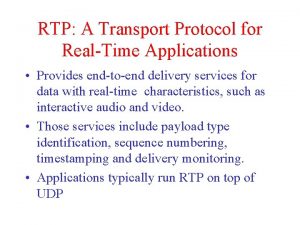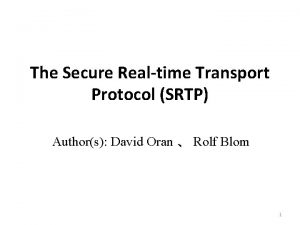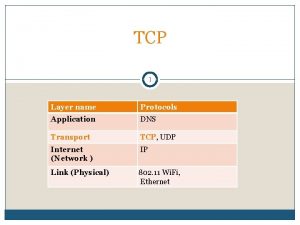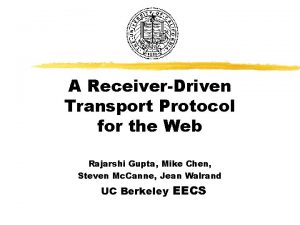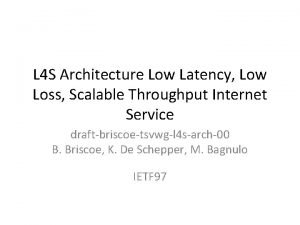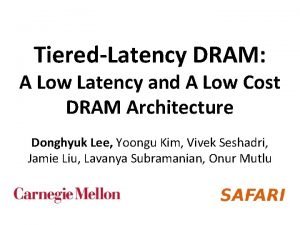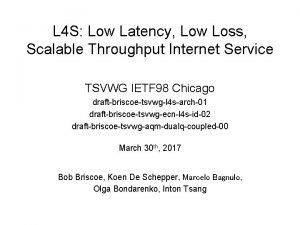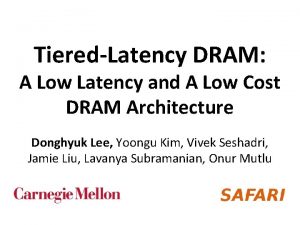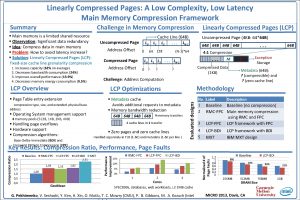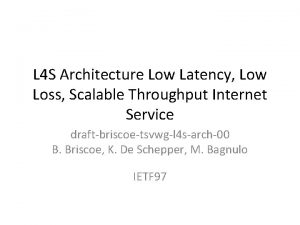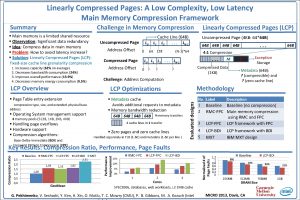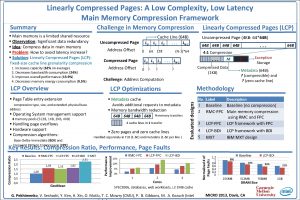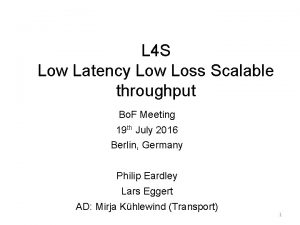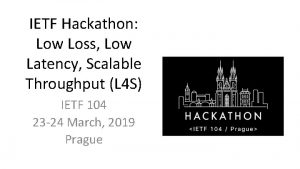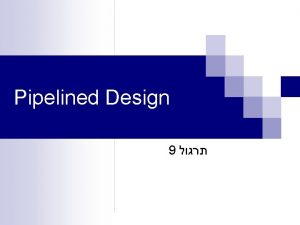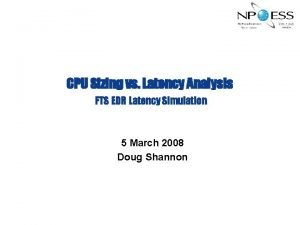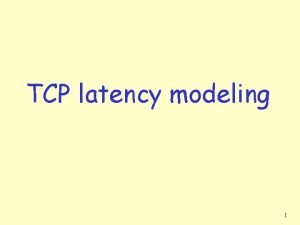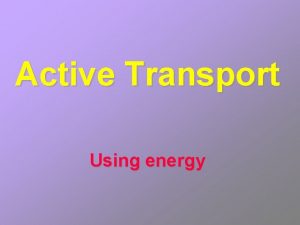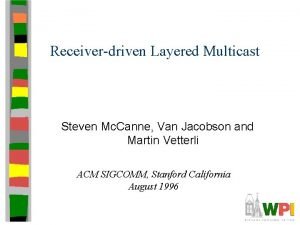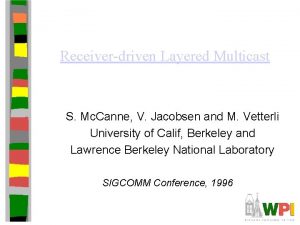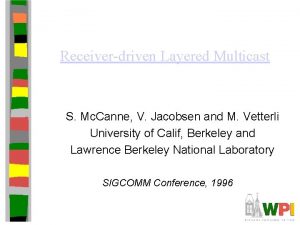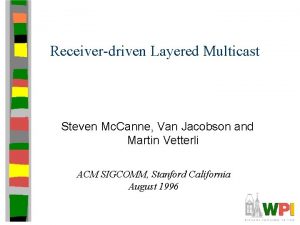Homa A ReceiverDriven Low Latency Transport Protocol Using


























- Slides: 26

Homa: A Receiver-Driven Low. Latency Transport Protocol Using Network Priorities Behnam Montazeri Joint work with: Yilong Li, Mohammad Alizadeh, John Ousterhout Aug. 22, 2018 Slide 1

Goals & Key Results ● Goal: A datacenter transport for low latency at high load ▪ Close to hardware limit latency for short messages ▪ High network bandwidth utilization ▪ Practical design for commodity fabrics ● Key results: 100 x faster than best published testbed implementation ▪ 15 us tail latency (99%ile) for short messages, at 80% load ▪ High bandwidth utilization: more than 90% of available bandwidth ● Key idea: Effective use of network priorities ▪ Dynamically assigned priorities by receivers ▪ Receiver-driven packet scheduling ▪ Controlled overcommitment on receiver’s downlink Aug. 22, 2018 Homa Transport, SIGCOMM 2018 Slide 2

Tiny Messages, Tiny Latency ● Short messages dominate workloads ▪ W 1, W 2: 95% of messages shorter than 1000 Bytes ● Prior work assumed large messages ▪ W 5: 100 KB message considered short ● A tiny 200 Bytes message, one way latency, ~5μs Aug. 22, 2018 Prior work “short” messages Homa Transport, SIGCOMM 2018 Slide 3

Near-Hardware Tail Latency is Hard ● For tiny messages, small inefficiencies have large impact ▪ 8 packets of queueing adds 10μs of latency at 10 Gbps → 3 x minimum completion time for a 200 -byte message ● Such queues have minor impact on larger message sizes ▪ Aug. 22, 2018 A 100 KB message takes > 80μs to transmit Homa Transport, SIGCOMM 2018 Slide 4

Prior Work Low Latency ● Reduce buffering: ▪ DCTCP(sigcomm 10), HULL(nsdi 12), PDQ(sigcomm 12), NDP(sigcomm 17) ▪ Can’t eliminate buffering, particularly at tail under high load ● Use in network priorities: ▪ p. Host(conext 15), PIAS(nsdi 15) , QJump(nsdi 15) ▪ Do not use priorities effectively, suffer head of line blocking ● p. Fabric(sigcomm 13): near optimal latency, but needs switch modification Aug. 22, 2018 Homa Transport, SIGCOMM 2018 Slide 5

Some Buffering Is Inevitable ● Low latency: senders must blindly transmit at full rate ▪ Multiple blind transmission Induces buffering Increases latency Sender 1 Sender 2 Aug. 22, 2018 Datacenter Network Fabric ● Buffering also needed for high BW Utilization Homa Transport, SIGCOMM 2018 Receiver Slide 6

Low Latency Requires Priorities Sender 1 Sender 2 Aug. 22, 2018 Datacenter Network Fabric ● Use hardware provided priority queues Receiver Buffered low-priority packets Homa Transport, SIGCOMM 2018 Slide 7

Best to Choose Priorities at Receiver Sender 1 Sender N Datacenter Network Fabric Congestion at TORReceiver downlink Multi-path core fabric: congestion rare TOR-Receiver Downlink Receiver Aug. 22, 2018 Homa Transport, SIGCOMM 2018 Slide 8

Priorities, Key To Low Latency ● Homa: using priorities effectively to bypass buffering ▪ Schedule messages in shortest-remaining-first order (SRPT) ▪ Near-optimal average latency & good tail latency for short messages ● Combine three mechanisms to use priorities effectively 1. Dynamically assigned network priorities by receivers ● Bypass queues for short messages 2. Receiver-driven packet scheduling ● Reduce buffer occupancy & improve latency 3. Controlled overcommitment on receiver’s downlink ● Avoid bandwidth waste, leads to high bandwidth utilization Aug. 22, 2018 Homa Transport, SIGCOMM 2018 Slide 9

Receiver Based Packet Scheduling ● Basic mechanism like p. Host and NDP: ▪ Send RTTBytes Unscheduled packets blindly ● RTT=10 us, @ 10 Gbps RTTBytes=12 KB ▪ Receivers schedule remaining packets: one Grant per Scheduled packet ▪ Optimal latency for one sender, one receiver scenario Message Sender 1 Unscheduled 1 RTT Scheduled Data Packets Receiver/TOR Unscheduled Data Packets Aug. 22, 2018 Grant Packets Homa Transport, SIGCOMM 2018 Slide 10

Receiver Based Packet Scheduling ● ● Basic mechanism like p. Host and NDP: ▪ Send RTTBytes Unscheduled packets blindly ▪ Receivers schedule remaining packets: one Grant per Scheduled packet ▪ Optimal latency for one sender, one receiver scenario Competing senders, grant only the shortest message(s) Sender 1 Receiver/TOR Grant Sched. Unsched. Sender 2 Aug. 22, 2018 Homa Transport, SIGCOMM 2018 Slide 11

Packet Scheduling Not Enough! ● Works well for long messages, but problematic for short messages ● Buffering creates preemption lag ▪ ● Short messages scheduling takes at least on RTT to come to full effect Unscheduled messages (no receiver control) Sender 1 Receiver/TOR Grant Sched. Unsched. Sender 2 Aug. 22, 2018 Homa Transport, SIGCOMM 2018 Slide 12

Using Network Priorities ● Goal: set priorities dynamically based on incoming messages ● Receiver specifies priorities: ▪ Scheduled packets: adaptive priority in each grant ▪ Unscheduled packets: In-advance priority cutoffs ▪ Assign higher priority levels for unscheduled packets Cutoff: 2 k. B < Message Size < 5 k. B, Unsched. Prio: P 6 Unscheduled Sender Prio. P 1 for sched. Pkt 1 Scheduled G 1 Aug. 22, 2018 TOR priority queues P 7 P 6 P 5 prios P 4 P 3 P 2 P 1 prios P 0 Receiver Prio. P 2 for Sched. Pkt 2 G 2 Homa Transport, SIGCOMM 2018 Slide 13

Unscheduled Priority Assignment ● Goal: distribute traffic evenly among priority levels ● Fraction of prios for unscheduled = fraction of incoming bytes unsched. Example: 75% bytes unsched. 25% bytes sched. TOR priority queues P 7 P 6 P 5 P 4 P 3 P 2 P 1 P 0 Receiver ● Pick cut-offs based on CDF of message sizes ▪ Shorter messages, higher unsched. Priority ▪ Equal bytes per priority level Aug. 22, 2018 Homa Transport, SIGCOMM 2018 Slide 14

Scheduled Priority Assignment ● ● Allocate adaptively based on incoming messages ▪ Start with lowest priority ▪ Use higher priority for rapid preemption Initial approach: only grant to higher priority message (like p. Host) P 0 Aug. 22, 2018 New short message arrives P 1 P 0 Homa Transport, SIGCOMM 2018 Slide 15

Problem: Wasted Bandwidth ● Senders may not respond promptly to grant ● Result: wasted bandwidth at receiver down link Prefers m 2 to m 1 S 1 m 2 m 3 S 2 Wasted BW Prefers m 1 to m 3 R 2 R 1 Slide 16 Aug. 22, 2018 Homa Transport, SIGCOMM 2018

Solution: Controlled Overcommitment ● Goal: keep links busy while prioritizing short messages ● Receiver grants multiple senders simultaneously ● ▪ Different priority level for each message ▪ Shortest message gets highest priority Priorities to favor short message, buffering for high BW utilization Both senders respond m 1 m 3 S 1 P 1 m 1 Aug. 22, 2018 S 2 Sender 1 doesn’t respond m 1 P 0 m 3 S 1 P 1 R 1 Homa Transport, SIGCOMM 2018 S 2 P 0 m 3 Slide 17

Testbed Implementation ● Implemented Homa in RAMCloud storage system ▪ ~4000 lines of code ● Testbed cluster: 8 clients, 8 servers ▪ Client sends a message of a given size ▪ Server replies with the same message ▪ All nodes in a cluster are connected to a single switch ● Cluster configuration: ▪ Cloud. Lab m 510 cluster: 8 -Core Xeon D 1548 @ 2. 0 GHz, 10 Gbps network ▪ Local Infiniband cluster: 4 -Core Xeon X 3470 @ 2. 93 GHz, 24 Gbps network Aug. 22, 2018 Homa Transport, SIGCOMM 2018 Slide 18

Homa Implementation Results ● 99%-ile slowdown < 3 x at 80% load for most messages ▪ Slowdown = message latency, normalized to latency in unloaded network 10% Aug. 22, 2018 20% 30% Workload: W 4 40% 50% 60% 70% Homa Transport, SIGCOMM 2018 80% 90% 100% Slide 19

Infiniband VS. Homa ● Infiniband suffers severe head of line blocking ● Infiniband with multiple connections, performs 20 x worse than Homa ▪ Not scalable: can’t afford to keep too much connection state 10% 20% 30% 1000 x HOL blocking Aug. 22, 2018 Workload: W 4 40% 50% 60% 70% Multi Conn. Reduces HOL blocking Homa Transport, SIGCOMM 2018 80% 90% 100% Infiniband Multi Conn. Homa Slide 20

No Prios & Uncontrolled Overcommitt. ● Basic: Receiver scheduler, single priority level, infinite overcommitment ▪ Fair share scheduling instead of SRPT ● At least 15 x difference between Basic and Homa 10% 20% 30% Workload: W 4 40% 50% 60% 70% 80% 90% 100% Queue Delay at TOR Aug. 22, 2018 Homa Transport, SIGCOMM 2018 Slide 21

Controlled Overcommittment Effect ● Homa. P 1: Homa with single priority and 7 overcommitment ● Controlled Overcommit: shorter queue sizes, less head-of-line blocking 10% 20% 30% Workload: W 4 40% 50% 60% 70% 80% 90% 100% 3 x Reduced HOL blocking Aug. 22, 2018 Homa Transport, SIGCOMM 2018 Slide 22

Effect Of Priorities ● Homa. Pi: Homa with i priorities and 7 overcommitment ● More priorities, further reduces HOL blocking for short messages 10% 20% 30% Workload: W 4 40% 50% 60% 70% 80% 90% 100% More priority, less HOL blocking Aug. 22, 2018 Homa Transport, SIGCOMM 2018 Slide 23

Simulation Evaluation ● Homa’s 99%ile tail latency <6 us at 80% network load (slowdown < 2 x) 10% Aug. 22, 2018 20% 30% 40% 50% 60% 70% Homa Transport, SIGCOMM 2018 80% 90% 100% Slide 24

Summary ● Homa provides low latency at high load ▪ Close to hardware limit latency for short messages ▪ High network bandwidth utilization ▪ Practical design for commodity fabrics ● Key results: 100 x faster than best published testbed implementation ▪ 15 us tail latency (99%ile) for short messages, at 80% load ▪ High bandwidth utilization: more than 90% of available bandwidth ● Key idea: Effective use of network priorities ▪ Dynamically assigned priorities by receivers ▪ Receiver-driven packet scheduling ▪ Controlled overcommitment on receiver’s downlink Aug. 22, 2018 Homa Transport, SIGCOMM 2018 Slide 25

Homa Source Code ● Homa Simulator: ▪ ● Testbed implementation in RAMCloud: ▪ ● https: //github. com/Platform. Lab/Homa. Simulation https: //github. com/Platform. Lab/RAMCloud Stand alone implementations (under development): ▪ Linux Kernel: https: //github. com/Platform. Lab/Homa. Module ▪ Userspace RPC: https: //github. com/Platform. Lab/Homa Aug. 22, 2018 Homa Transport, SIGCOMM 2018 Slide 26
 Homa
Homa Cmaf vs webrtc
Cmaf vs webrtc Low latency dispersion compensator
Low latency dispersion compensator Lola low latency
Lola low latency Low latency microservices in java
Low latency microservices in java Lola system
Lola system Sparrow scheduling
Sparrow scheduling Generic low latency
Generic low latency Homa ir valores
Homa ir valores Homa farming definition
Homa farming definition Homa farming definition
Homa farming definition Insulina basal valores normales
Insulina basal valores normales Homa popal
Homa popal Die sonne im gesicht
Die sonne im gesicht Indice de homa
Indice de homa Homa ildikó
Homa ildikó Mid = low + (high - low) / 2
Mid = low + (high - low) / 2 Communication style bias
Communication style bias Significant figures
Significant figures Low voltage hazards
Low voltage hazards Low level protocol
Low level protocol Active buttons
Active buttons Exocytosis active or passive
Exocytosis active or passive A transport protocol for real time applications
A transport protocol for real time applications Internet transport protocol in computer networks
Internet transport protocol in computer networks Secure real time transport protocol
Secure real time transport protocol Dns transport layer protocol
Dns transport layer protocol
